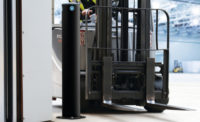A rising worldwide consumer class and growing demand for healthier products is creating enormous opportunity for today’s food and beverage manufacturers. However, as companies adjust to these trends, they must do so while managing several factors that can threaten profitability, including food safety, labor and commodity process.
And, these high-profile factors aren’t the only threats to profitability. As they work to manage more large-scale issues, companies often overlook the operational profitability threats in their own facilities. One of these potential threats comes in the form of batteries, or more specifically, the use of batteries that are poorly suited to cold storage and freezer applications. The costs associated with the maintenance, repair and replacement of batteries coupled with the associated downtime can add up fast, hurting profitability and diverting much-needed resources from more strategic businesses initiatives.
Lost capacity in cold storage and freezer applications
While it’s no secret that cold temperatures can reduce battery power, the potential reductions can be surprisingly high. Depending on the internal temperature that a battery reaches in a cold storage area, its power capacity losses can range between 20-60%. With an internal temperature of 32°F, for example, a fully charged conventional lead acid battery will only deliver 75% of the capacity it would at normal room temperature (77°F). With an internal temperature of 0°F, that same battery’s capacity would drop to 40%.
What causes these power capacity losses? Simply put, exposure to cold temperatures increases the viscosity of a battery’s electrolyte. As the electrolyte fluid thickens, its diffusion through the pores of the active battery plate slows, making it harder to achieve the chemical reaction needed to power the lift truck. As temperatures and power capacities fall, the corresponding drop in run times can be significant – a battery designed to run for eight hours in ambient environments may only last 4-6 hours in cold storage facilities.
Colder means more complicated charging
Cold-driven reductions in battery run times can make it very difficult for operators to maintain proper run, charge and cool cycles. This failure can in turn lead to a vicious cycle of poorly charged and prematurely swapped batteries exhibiting shorter and shorter run times. The end result is decreased battery life and unnecessarily higher battery costs.
Along with affecting charging cycles indirectly through reduced run times, cold temperatures also have a direct impact on battery charge acceptance. Once a battery’s internal battery temperature falls below 40°F, its voltage will appear higher than it actually is. Under such conditions, battery discharge indicators will show an incorrectly higher battery power capacity. Similarly, chargers will also misread voltage levels as higher than what they really are and will shut off prematurely, contributing to even shorter battery life.
So, how can you combat the effects of cold temperatures on batteries?
By employing a battery specifically developed for low-temperature environments. Here’s what to look for.
Electrolytes and thick plates. In cold applications, electrolyte solutions can go a long way toward combating capacity loss at the lower depth of discharge rates. Look for a battery with an electrolyte solution specially designed for cold environments, and that integrates well with other advanced battery technology – particularly with thick, corrosion-resistant plates that have a high lead content. This combination will improve conductivity in cold temperatures, especially during peak demand periods.
Thermal tray insulators. In cold storage and freezer applications, it’s the lift truck battery’s outer cells that are most affected by low temperatures. A thermal tray insulator will keep the outer cells warmer and enable more effective capacity and voltage levels overall. Ideally, the tray will be protected with an epoxy to guard it against moisture-induced corrosion to reduce rust, voltage tracking and short circuits.
Easier charging and maintenance. Voltage misreading can lead to chronic undercharging in cold temperatures. Make sure your battery features a charge profile that makes it suitable for use with any charger programmed for the demands of cold store applications.
In addition, flip-top vent caps can help keep electrolyte from dripping into cell covers and eliminate the possibility of lost caps, substantially reducing maintenance-related downtime.
Better batteries, better business
If companies want to be nimble enough to respond to emerging industry trends, they need the resources to do it. The efficiency and profitability lost due to poor battery performance, while often overlooked, can have a big impact. With the right battery, it doesn’t have to.





